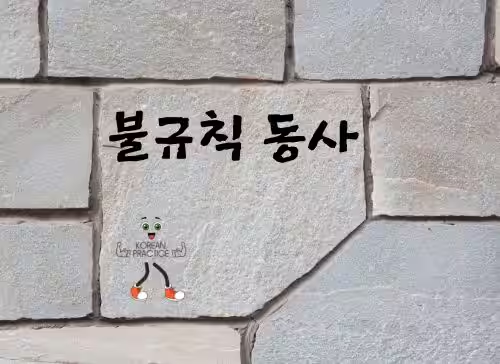- No Comments
- suhchangwhoon
- April 17, 2025
Table of Contents
Understanding Irregular Korean Verbs: The Key to Fluid Korean Speech
Learning Korean can be an exciting journey, but encountering irregular Korean verbs for the first time can feel overwhelming. Unlike regular verbs that follow consistent conjugation patterns, irregular verbs change their stems in certain situations, creating exceptions to the rules you’ve diligently memorized.
The good news? These irregularities actually follow predictable patterns. Once you understand these patterns, you’ll find that Korean verb conjugation becomes much more intuitive. Many students wonder how many irregular verbs in Korean they need to learn. While the exact number varies depending on ho
Why Irregular Verbs Matter
Mastering irregular Korean verbs is crucial because they include some of the most commonly used verbs in everyday Korean conversation. Verbs like 듣다 (to hear/listen), 춥다 (to be cold), and 아름답다 (to be beautiful) all follow irregular patterns. An irregular Korean verbs list typically includes these common patterns: ㅂ, ㄹ, ㅅ, 르, ㄷ, 으, and ㅎ irregulars.

The Main Types of Irregular Korean Verbs
- Without proper knowledge of these irregularities, you might find yourself making frequent grammatical errors that could affect how clearly you communicate. Let’s break down the most common types of irregulars you’ll encounter in your Korean language learning journey:
ㅂ (bieup) Irregular Verbs
This is one of the most common irregular patterns. Verbs ending with ㅂ transform when followed by a vowel.
For example:
- 춥다 (to be cold): 추워요 (it’s cold)
- 덥다 (to be hot): 더워요 (it’s hot)
- 맵다 (to be spicy): 매워요 (it’s spicy)
The ㅂ changes to 우 or 오 depending on the vowel harmony.
Example
Original Korean Sentence
날씨가 너무 추워요.
Pronunciation Guide
날씨가 (nal-ssi-ga) 너무 (neo-mu) 추워요 (chu-wo-yo).
Meaning and Context
날씨 (weather) 가 (subject marker) 너무 (too much) 춥 (to be cold) * 어요 (is; I’m telling you polite and friendly).”
Pronunciation Patterns for Conjugations
⊳ 춥 + 어요 = 추워요. The ㅂ changes to 우 when followed by a vowel.
⊳ But I teach it this way: 춥 + 어요 = 추워요. Rapidly pronouncing ‘춥’ and ‘어’ results in ‘추워’.
English Translation
The weather is very cold.
Literal Translation
Weather is too cold.
ㄹ (rieul) Irregular Verbs
Verbs ending with ㄹ often drop this final consonant when certain endings are attached.
For example:
- 알다 (to know): 아는 (knowing)
- 살다 (to live): 사는 (living)
- 팔다 (to sell): 파는 (selling)
Example
Original Korean Sentence
서울에 사는 사람들은 바빠요.
Pronunciation Guide
서우레 (seo-u-re) 사는 (sa-neun) 사람드른 (sa-ram-deu-reun) 바빠요 (ba-ppa-yo).
Meaning and Context
서울 (Seoul) 에 (in) 살 (to live) * 는 (present participle) 사람 (person) 들 (plural) 은 (topic marker) 바쁘 (to be busy) * 어요 (are; I’m telling you polite and friendly).”
Pronunciation Patterns for Conjugations
⊳ 살 + 는 = 사는. The ㄹ is dropped when followed by 는.
⊳ But I teach it this way: 살 + 는 = 사는. Rapidly pronouncing ‘살’ and ‘는’ results in ‘사는’ to make it easier.
Grammar
* 는: people (who) live
English Translation
People who live in Seoul are busy.

Want to learn Korean in a simple and structured way, just like this? My courses break down grammar step by step, making Korean easy to understand. Plus, you can try free sample lessons. Ready to start?
ㅅ (siot) Irregular Verbs
With these verbs, the ㅅ disappears when followed by a vowel.
For example:
- 낫다 (to recover): 나아요 (recovering)
- 짓다 (to build): 지어요 (building)
- 붓다 (to pour): 부어요 (pouring)
Example
Original Korean Sentence
그 사람이 집을 지어요.
Pronunciation Guide
그 (geu) 사라미 (sa-ra-mi) 지블 (ji-beul) 지어요 (ji-eo-yo).
Meaning and Context
그 (that) 사람 (person) 이 (I’m going to talk about hime) 집 (house) 을 (my object is a house) 짓 (to build) * 어요 (I’m telling you polite and friendly).
Pronunciation Patterns for Conjugations
⊳ 짓 + 어요 = 지어요. The ㅅ disappears when followed by a vowel.
⊳ But I teach it this way: 짓 + 어요 = 지어요. Rapidly pronouncing ‘짓’ and ‘어’ results in ‘지어’ to make it easier.
Grammar
* 이/가: Subject marker used with a noun. “이” is used after words ending in a consonant, and “가” is used after words ending in a vowel.
English Translation
He is building a house.
Literal Translation
That person build house.
르 (reu) Irregular Verbs
These verbs undergo a transformation where 르 changes to ㄹ라/ㄹ러.
For example:
- 모르다 (to not know): 몰라요 (don’t know)
- 부르다 (to call/ sing): 불러요 (calling, singing)
- 자르다 (to cut): 잘라요 (cutting)
Example
Original Korean Sentence
제가 노래를 불러요.
Pronunciation Guide
제가 (je-ga) 노래를 (no-rae-reul) 불러요 (bul-leo-yo).
Meaning and Context
제 (I) 가 (I am going to talk about what I should do) 노래 (song) 를 (object marker) 부르 (to sing) * 어요 (am; I’m telling you polite and friendly).
Pronunciation Patterns for Conjugations
⊳ 부르 + 어요 = 불러요. The 르 changes to ㄹ러 when followed by a vowel.
⊳ But I teach it this way: 부르 + 어요 = 불러요. Rapidly pronouncing ‘부르’ and ‘어’ results in ‘불러’ to make it easier.
English Translation
I am singing a song.
Literal Translation
I sing song.
ㄷ (digeut) Irregular Verbs
The final ㄷ changes to ㄹ when followed by a vowel.
For example:
- 듣다 (to listen): 들어요 (listening)
- 묻다 (to ask): 물어요 (asking)
- 걷다 (to walk): 걸어요 (walking)
Example
Original Korean Sentence
저는 라디오를 들어요.
Pronunciation Guide
저는 (jeo-neun) 라디오를 (ra-di-o-reul) 드러요 (deu-reo-yo).
Meaning and Context
저 (I) 는 (as for me) 라디오 (radio) 를 (object marker) 듣 (to listen) * 어요 (I’m telling you polite and friendly).
Pronunciation Patterns for Conjugations
⊳ 듣 + 어요 = 들어요. The ㄷ changes to ㄹ when followed by a vowel.
⊳ But I teach it this way: 듣 + 어요 = 들어요. Rapidly pronouncing ‘듣어’ and ‘어’ results in ‘들어’ to make it easier.
English Translation
I listen to the radio.
Literal Translation
I listen radio.
Common Mistakes with Irregular Korean Verbs
When practicing Korean grammar, be careful to avoid these common pitfalls:
- Overgeneralizing irregular patterns to regular verbs
- Forgetting that some verbs might look like they should be irregular but are actually regular
- Applying the wrong irregular pattern to a verb
Conclusion: Mastering Irregular Korean Verbs
The path to mastering irregular Korean verbs is through consistent practice and exposure. While they may seem challenging at first, these patterns will eventually become second nature. Comprehensive Korean irregular verbs conjugation charts can be helpful tools for visual learners to recognize patterns across different tenses and forms.
Remember that even native Korean speakers learned these patterns through repeated use rather than grammatical analysis. By incorporating these verbs into your daily Korean practice, you’ll gradually develop an intuitive sense for the correct conjugations.
What irregular Korean verb pattern do you find most challenging? Practice makes perfect, so keep engaging with Korean content, forming sentences, and before long, conjugating irregular Korean verbs will feel as natural as any other aspect of your Korean language
Sign up for my newsletter and get
📖 Korean short stories
🎧 Listening practice with audio
❓ Vocabulary and grammar quizzes
🎁 Free courses
📝 Blog updates
– all delivered straight to your inbox!


